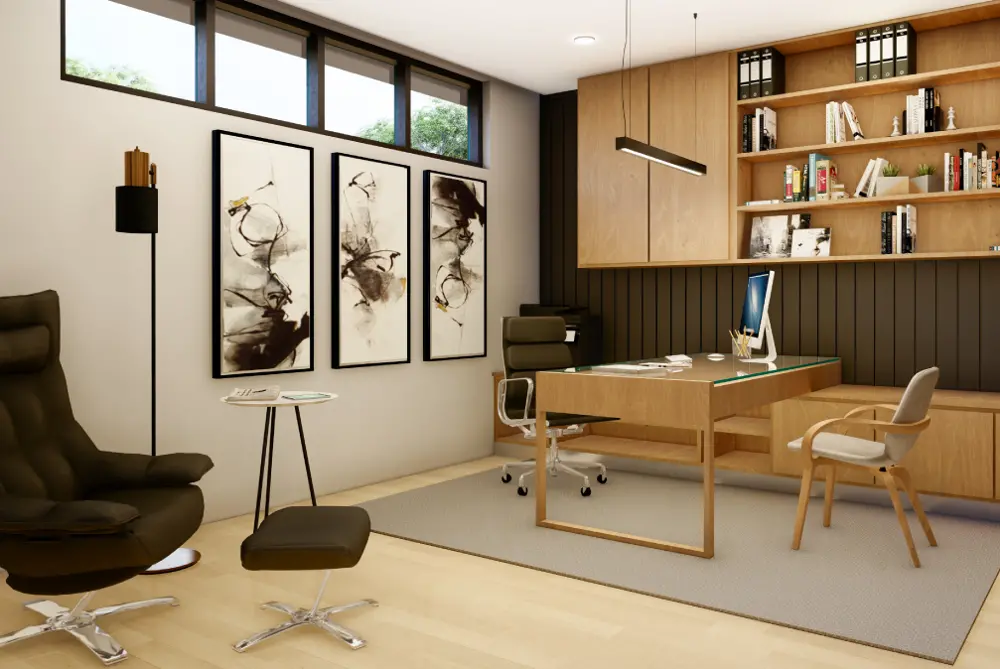Created by: Federica Chacon
Date: Jan/24/2024

Source: www.homboo.com
Back in the day, home offices used to be a "just in case I need to get something done during the weekend" type of thing, and if you didn't have one, you wouldn't have sacrificed a guest room to set up a desk and your computer. Nowadays, this has changed drastically. Today many of us work remotely and take the bulk of our tasks (if not all) from home. So, we need more than some haphazardly work set up to get us through our days with comfort and productivity.
When setting up your home office, there are a few things to consider: decor, furniture, buying a perfect work chair, cord placement, window/natural light, and keeps going. Nonetheless, none of these things can happen without having a specially designed space dedicated to it. As soon as we decide we need a home office in new home, the next question is: where should it be located? Thus, its location becomes an important matter that needs to be analyzed and answered correctly. Therefore, you should consider some aspects that will make its placement even more successful. We'll break those down for you:
1. In a room or an open space?
Residential architects and home designers would agree that including a designated space/room for your home office in your new home’s floor plan is much better than using a leftover space in the living, dining, or even in the bedroom to set up your things. Having a separate room means you can emulate that "going to work" and "coming back home" mentality, which enhances your disposition to work and positively affects your productivity. It also signals to everyone else in the household that you are in "work mode" and will likely be far less interrupted during the day.
2. Natural sunlight
Having a window is a tremendous plus. We know it might seem perfectly fine to use a little den or makeover a closet, but staring at the same wall all day without a ray of sunshine is tough and tiring! Looking outside, having direct sunlight, and maybe seeing some flowers have proven to work wonders for our mental health. It also means we have a dynamic scenery in front of us, which can be very refreshing and signal how much time has passed to keep a clear perspective when working.
3. Artificial light
Just like natural scenery and sunshine can do wonders for your mood, good artificial light can be fantastic for your attention, productivity, and, more importantly, your eye and overall health. But on the other hand, not having good lighting can lead to eye stress, bad posture, cramped neck, and tired back. These are the types of things that, when you have to put up with them for a few days, they're fine, but in time they will take a toll on your eyesight and posture.
4. Designing a room size related to your needs
Try to think realistically about how much space you'd need to conduct your daily activities comfortably. Think about what size desk would do the trick if you need to set up monitors, maybe a TV/monitor on a wall, a printer, or need spaces for physical paperwork, what your dream chair looks like and its size, or even maybe a sofa, or a chaise lounge chair, etc. These variables will determine the amount of space you would need to set up your home office successfully and not feel like you're in Harry Potter's cupboard under the stairs. Picking a room size consistent with your needs will make the space feel open, refreshing, and sufficient instead of closed, stressful, and cramped. Remember, this investment backs up your productivity (which could even save your money in the long run).

Source: www.homboo.com
5. Where the room is located in regards to other spaces
Finding the perfect size and type of room is sadly not enough if you’re next to, for example, the laundry room, where there is constant noise breaking your focus. This could even be considered the baseline requirement for a functioning home office: a good location. You can of course adjust other things such as soundproofing to the room but this is always an extra which is suggested.
Ideally, you would be looking for a room that is opposite of a typically noisy area such as the living room or the laundry room, close to a bathroom, so you can go for quick bathroom breaks in between meetings and not have to dart upstairs; and preferably close to the kitchen so you can have your snacks and refreshments on hand. (View the floor plan above)
At Homboo, you will find that architects usually place home offices next to a bathroom, close to the front/main door, at a not to long walking distance to the kitchen, directly opposite of the living room and below the bedrooms. This way, we get all of the comfort needed to get a good day of work without distractions.
What’s next
After thinking about all of the above, it is then time to figure out what type of decor you’d like for your backdrop in Zoom meetings, what comfy lounge chair to include, if you’re going to hang up a piece of artwork and so forth. These five items are truly the most crucial since they are the ones that will determine if your home office will be a successful project or if it will end up forgotten and unused.